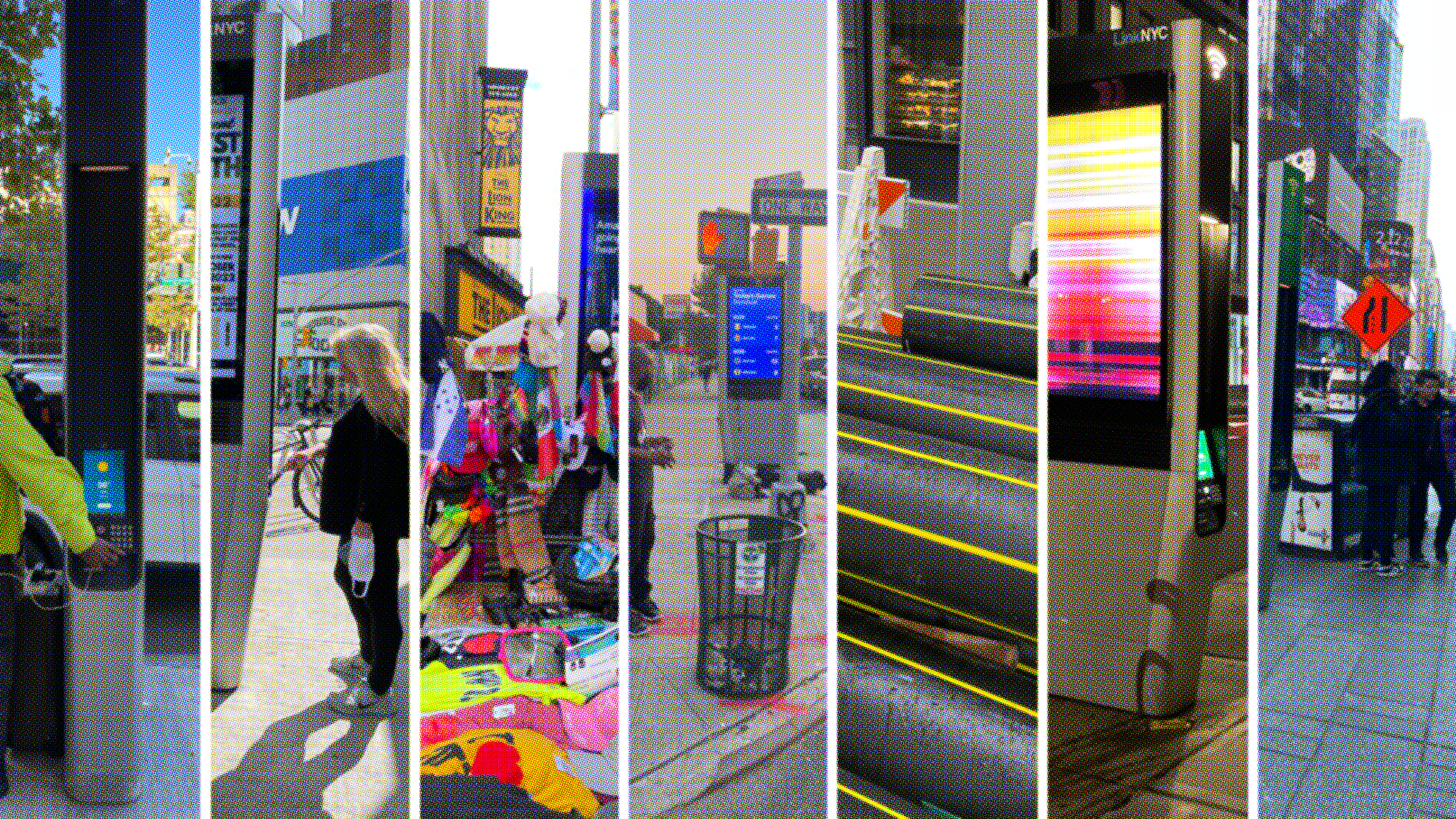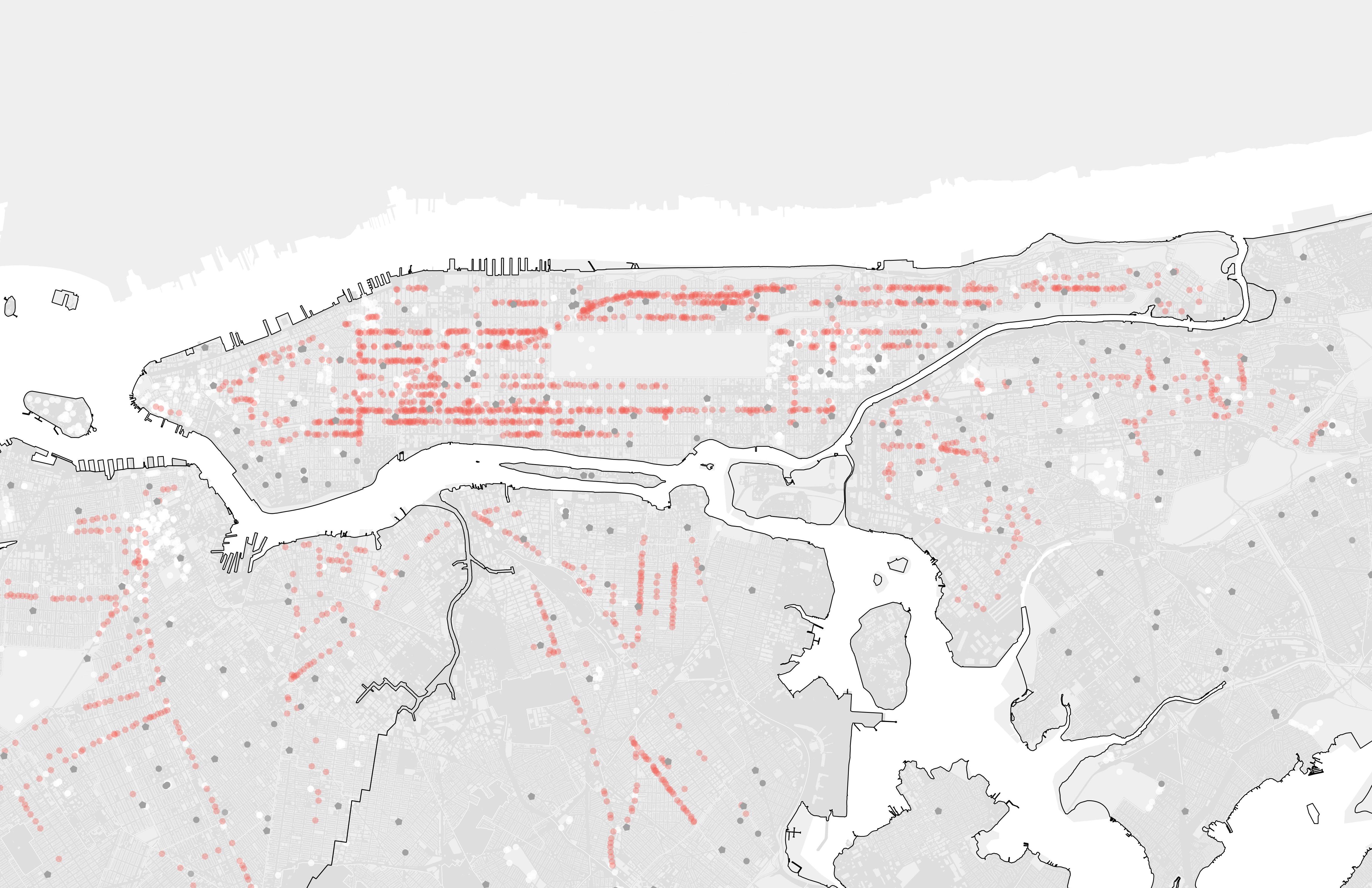

Scroll down to read about a series of urban design interventions. Click the images to enter immersive scenes depicting specific LinkNYC sites.
Eddie Joe Antonio | April 2023
On a warm day in Brooklyn, a small community will often gather on Fourth
Avenue and 24th Street. The size of the group changes, but you can
regularly find at least three people sitting in the short overhang of a
shuttered deli entrance. People play music, dominoes, and Instagram Reels.
A regular visitor named José explained to me the merits of spending “no
more than an hour on the same street everyday to be sure you know what’s
going on”. Sometimes, everyone locates around a short turn of the block,
dodging the sun in the heat and seeking it out in early spring. Watching
videos throughout the day, sharing social media posts, or otherwise simply
socializing, José and others hang out as the busy avenue rumbles past.
They do this in close proximity to a LinkNYC kiosk. The kiosks, housed in
sleek technological boxes, provide free WiFi, phone-calling, and other
modern services at no cost. Rolled out in 2015, the digital nodes replaced
the city’s aging public payphone system with a remarkable set of
communication tools. New Yorkers have observed their deployment with a mix
of excitement, anxiety, and fury–it seems no one in the city has forgotten
the unfortunate reporting of individuals watching pornography in early
2016 on their built-in tablets. Despite this infatuation with the unsavory
side of the system, few have a complete understanding of what the kiosks
really are, how they are used, or where they are mostly located.
Street activation at a LinkNYC kiosk on Lawrence Street in Downtown Brooklyn.
At its best, the LinkNYC kiosks are one component of a large public WiFi
system that fills in some gaps in broadband access around the city. Public
WiFi supports millions of New Yorkers while targeting those without the
funds at home or the physical infrastructure in their neighborhoods to get
high speed WiFi access. Termed the “digital divide”, it is evident that
access to modern communication infrastructure at an affordable cost is
highest in wealthier, whiter, and more centrally-located neighborhoods. We
know from collective recent experience how important broadband access is
for everything from child education to public health, and much data
suggests that the most vulnerable and marginalized New Yorkers bear the
brunt of the real impact of a lack of digital connectivity.
LinkNYC, as one of the thirteen providers of public WiFi in the city, is
the end product of a remarkable effort to tackle this issue. A coalition
of technologists, entrepreneurs, government, and advocacy stakeholders
designed the system as an intervention in the digital divide. They created
a vision for an innovative private-public partnership that provides
streetside services in this new and changing field of contemporary
telecommunications. The system today that developed from their efforts
operates across all five boroughs, permitting both stationary users and
on-the-go WiFi seekers to connect to the internet in many of the city’s
neighborhoods. Lots of other things are enabled by LinkNYC, too: free
telephone calls, USB charging, and a variety of other features on its
built-in tablet including a nearest bathroom finder. Perhaps as varied as
the city itself, users of the LinkNYC kiosks are utilizing these services
in dramatically different ways. On one block, a group of teenagers hangs
out while one of them charges their phone. On another block, neighbors
linger as they call home, wherever in that world that may be, both on the
built-in phone and through their internet-connected personal devices. And
on other streets we can often see the kiosks standing unused, weird blobs
futuristically broadcasting WiFi for all. I guess these kiosks simply
observe the city go by.
A busy site on Fourth Avenue and 24th Street in Brooklyn features music in the warmer months and a continous group of neighbors using the free WiFi.
The kiosks are always observing. At its worst, the LinkNYC kiosks are an
unequal product in our city that collect significant amounts of data about
our whereabouts and online activities. The rollout of the kiosks has
targeted the busy districts of the urban core, where most residents not
only already have access to high speed broadband at home but have
relatively high median household incomes. Neighborhoods such as Mott Haven
and Parkchester in the Bronx or Borough Park and Brownsville in
Brooklyn–areas with low access to broadband at reasonable rates with
low-income, marginalized communities–are entirely left out of the LinkNYC
program at the time of this writing. What’s more, users agree to a
legalistic privacy statement when first connecting their phones to the
WiFi or when opening up a session on the built-in tablets. The privacy
statement includes agreeing to having your device location, URL
clickstream, and MAC plus IP addresses recorded by LinkNYC for their use.
The services also require an email to connect on your device, a clear
barrier to entry for many who do not have an email or do not wish to
provide it. Intersection, the company that owns and operates the kiosks,
stores all this data in anonymized formats before using it to sell
advertisements on the built-in kiosk display screens. Surprised? You
shouldn’t be—Intersection’s parent company, Alphabet, has been excelling
at this model of targeted advertising for over a decade now with its most
famous product: GoogleAds.
In the frenetic heart of Times Square, a LinkNYC kiosk features a lot of diverse urban use.
The kiosks are additionally equipped with three video cameras, including
one that users can activate to make video calls. Intersection has, in the
past, published video surveillance taken from their 9 foot-high security
cameras, openly acknowledging their full cooperation with law enforcement
in sharing their footage. They have, however, noted that the cameras are
“usually turned off”, although many activists have questioned why the
kiosks would be equipped with cameras at all if this were the case.
Between the data collection measures, the ability to survey the street,
and the business model based on advertisement revenue, the kiosks
represent an entirely new way of providing services that could be
categorized as a surveillant capitalist model. This will definitely sound
blasphemous, but we can perhaps understand the uniqueness of this model by
imagining a public school that required we collect information
(anonymized, of course!) on students that we then used to sell ads in
order to fund their education. Sounds a little funky, no?
In Harlem, an underutilized kiosk is full of potential for activation on this neighborhood street.
Despite the tangible drawbacks to the LinkNYC model, it is evident that
the system is highly utilized by a wide variety of users in contemporary
New York. In what follows, I share in more detail my observations of the
incredible diversity of usages of four specific LinkNYC kiosks across the
city. What’s more, it remains a darling of the Adams administration, who
has even expanded the program dramatically by crafting a new division
known as Link5G that aims to use much larger kiosks to house 5G
technology. The next moves for Intersection involve a much-more stringent
requirement to locate 90% of their new kiosks outside of Manhattan below
96th Street–a move Dr. Bola Omotosho, chair of Bronx Community Board 5,
has described as the “best innovation of the 21st century”. While this
expansion is outside of the scope of this paper, it is noteworthy to
understand the continued significance of not only the history that led to
the system we have today but its current usage in 2023 as policymakers
move to expand it.

Public WiFi access points in and around Manhattan.
Over the past six months I’ve observed four specific LinkNYC kiosks,
documenting the activities and opinions of their users, and recording the
streetlife around these locations. I spent time with the small community
at Fourth Avenue and 24th Street and frequented a busy site on Lawrence
Street in Fulton Mall. I jammed my way into Times Square, documenting the
activity at a rambunctious kiosk on W 45th Street. And I’ve observed a
LinkNYC on W 123rd Street in Harlem, a shining metallic box that is barely
used. My process has involved arriving at a site and investing fifteen
minutes in observing, discussing, and debating the kiosks with anyone
willing to talk to me. I have done this with a sense of urgency and,
bizarrely, even a feeling of anxiety. It feels like the moment to act is
now, but it also feels unclear what the acting is on. What feels clearest
is the need to share and discuss where public WiFi is going, and why,
before we have closed the door on how it will be deployed.
I am convinced that what we have today is an example of New Yorkers making
lemonade out of lemons. Across the city, a system that raises questions
around privacy, surveillance, and equity is being used in spectacular
spatial, social, and entrepreneurial ways. From the perspective of an
urban planner, the activities of LinkNYC users have suggested deeply
impactful spatial design interventions that could affect a totally new and
unique node in urban life. What follows is a spatial walkthrough of each
of my four sites accompanied by a series of some of the design
interventions I am proposing based on my research. This is my highly
opinionated, minorly quantitative, and deeply qualitative set of
guidelines for how we can facilitate this urban design challenge–I look
forward to hearing yours.
Public WiFi Locations should interpret land use and economic patterns in their vicinity to locate more strategically Public WiFi solutions should include the robust telecommunications capacities of LinkNYC, especially the ability to communicate with other countries Public WiFi solutions need shade, heated, and cooled spaces Public WiFi solutions should include the ability to charge devices on the go, like in the current kiosks Public WiFi solutions should be spatially distributed according to the needs of the city and not related to the former locations of payphones Public WiFi solutions need to better communication their ability to surveil users and collect data, and otherwise better explain their business models